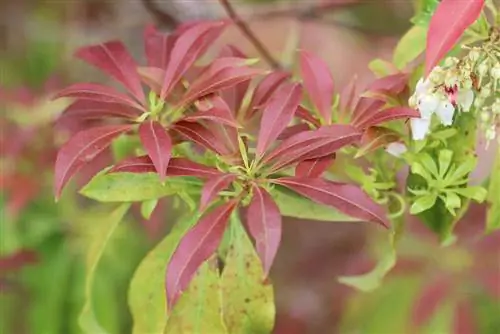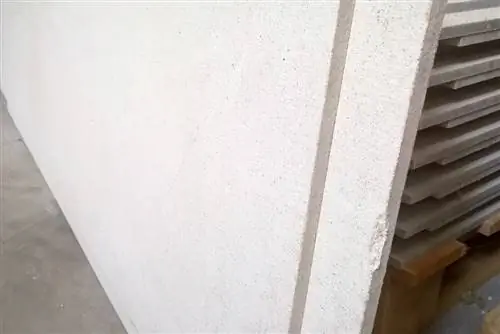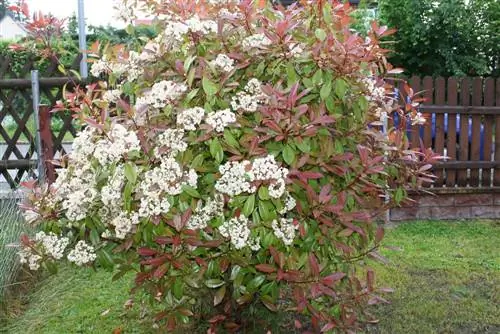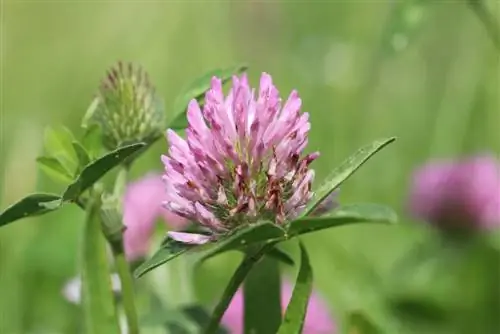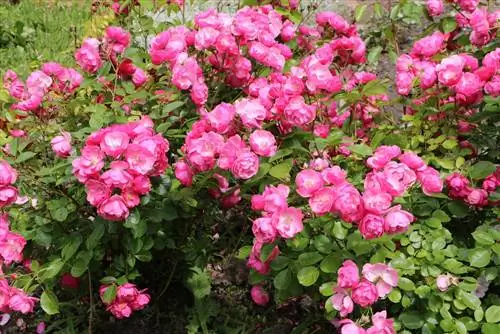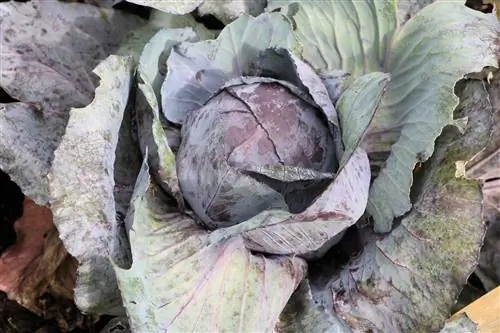- Author admin [email protected].
- Public 2023-12-17 03:39.
- Last modified 2025-01-24 12:45.
The loquat (Photinia fraseri) “Red Robin” is a distinctive, evergreen topiary whose leaves sprout red in spring. Grown as a standard tree, it is a colorful gem with its white flowers and the red berries that develop from them. Many loquat lovers place a plant in a pot on the right and left of the entrance. The plant, which originally comes from New Zealand and grows up to 3 m high, is not demanding to care for. However, there are important points to consider when cutting the tree trunk.
Plants
Photinia fraseri is best planted in spring so that the plants can grow well until winter. Baled goods are very suitable for this because they are easier to plant. The planting hole should be 1.5 times the size of the medlar root ball. After digging the planting hole, first fill it with a soil mixture loosened with humus before inserting the loquat. Do not plant the standard tree too deep. The upper edge of the bale must be flush with the surface of the garden bed or the pot soil. Tread the plant substrate well and water thoroughly.
Tip:
Before planting, soak the root ball in a bucket of water until no more air bubbles appear. The roots have to soak up really well so that they get a good start to growing.
Location
The high-stem cotoneaster likes sunny to partially shaded locations in an area protected from the wind. In shady areas, the flower and berry development suffers and the foliage does not turn so beautifully.
Floor
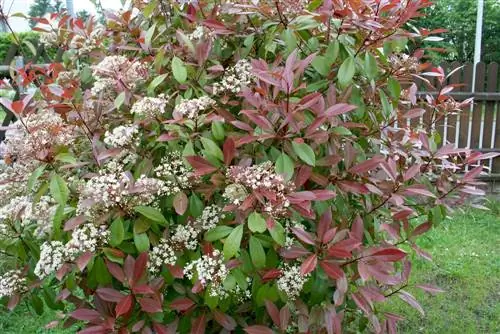
Humus-rich and well-drained soils are preferred for the standard loquat “Red Robin”. When planting in a pot, you can also mix commercial pot plant soil with humus. This is tolerated just as well by the standard loquat. The soil can be calcareous, alkaline, acidic or neutral. It just shouldn't become waterlogged, as this can cause the roots to rot. In addition, the leaves are then shed prematurely.
Pouring
Water the Photinia regularly and abundantly in the first 2 weeks after planting. After that, it is sufficient if you only water as soon as the surface of the garden soil or the plant substrate in the pot has dried. It is best to test the moisture of the soil with a finger. If the substrate remains stuck, the soil still has enough moisture. However, when watering, make sure that the soil is not too wet, but not too dry either. Choose the happy medium here.
Tip:
If the standard cotoneaster is in the pot, it should always be ensured that the excess water can drain away.
Therefore, remove the water from the saucer regularly or place the plant pot on pot feet from the start. These are commercially available in various shapes, sometimes with funny animal motifs.
Fertilize
It is best to fertilize the loquat in the pot in spring with a slow-release fertilizer or commercially available liquid fertilizer. For standard loquats planted in the garden, a little compost is sufficient in spring, which is lightly worked into the garden soil.
Cutting
Tall stems need to be trimmed well into shape regularly, otherwise they will grow back into bushes. To do this, first remove all hanging branches of the loquat, but leave young shoots that branch off from them. Then look at the branches that are still upright but are bare. Cut these off at the base. This encourages the standard loquat to produce fresh, new wood the following year and the crown becomes more compact. This gives it a beautiful, spherical, aesthetic shape. Do not leave any branches that grow upwards or to the side from the spherical crown. Remove weak wood and cross shoots from young wood. It is always cut to just above an outward-facing bud.
Tip:
Always cut the standard loquat tree trunk with sharp, germ-free garden or pruning shears and always make sure that none of the branches are torn.
Because injuries can be entry points for pathogens. It is best to close larger cuts from the outset with a commercially available wound closure agent that also repels pathogens and fungi.
Wintering
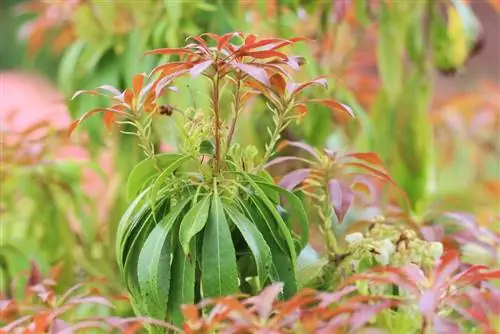
The loquat is hardy down to temperatures of -20 °C. Young plants in the garden and in pots need winter protection. Pack the plants well in leaf mold, jute bags or brushwood. You should also not expose the red robin in the pot to much winter sun. It is therefore advisable to overwinter the potted plants indoors at 10 to 15 °C or completely wrapped up in a protected location on the terrace. Remember to water regularly even in winter, but not as often and a little more sparingly than in summer. Standard trees in solitary plantings in the garden also need to be watered in winter.
Planting combinations
As a standard loquat has a tree disc that can be planted, for example, with early bloomers and year-round ground cover such as evergreens or mock strawberries. But astilbe, dwarf iris and dwarf columbine are also beautiful plants for underplanting. An equally beautiful arrangement is created for the standard cotoneaster with flowering trees and perennials in its vicinity.
Woods:
- Forsythia
- Cherry Laurel
- Pipe Bush
- Deutzie
Perennials:
- fragrant phlox
- Marguerite
- Scabioses
- Knapweeds
Propagate
Red Robin can be propagated either by seeds, cuttings or cuttings. The lowering stems are taken from a bush-shaped loquat, as the distance from the crown to the ground is very long on the standard tree.
Seeds
You can take the seeds from the berries of your own Photinia fraseri in the container or garden. It is best to sow these in a so-called cold box or in a cold cold frame and overwinter them there frost-free. Straw mats and Styrofoam sheets are suitable as winter protection for the boxes. From May - after the Ice Saints - plant the small plants at their destination.
Cuttings
- cut head or shoot cuttings in summer
- or use the clippings from the topiary
- Cuttings should be slightly woody
- Shoot cuttings no longer than 15 to 20 cm
- Head cuttings no longer than 8 to 10 cm
- remove all leaves except three pairs of leaves
- Place cuttings up to 3 cm deep in potting soil
- either on the spot or in nursery pots
- pour lightly and put over a foil bag
- Air foil bags regularly
- place in a shady spot
- Grow in a pot and overwinter frost-free for at least 2 to 3 years
Diseases and pests

Sometimes red robin trees can be attacked by apple scab, aphids or black weevils. Horsetail tea is used as a plant strengthener and the leaves affected by apple scab are burned. If the infestation is very severe, it is unavoidable to use a scab control agent. However, you should avoid chemicals as much as possible so as not to destroy the natural balance in the garden. The best way to combat aphids is to spray garlic, nettle, horsetail or neem. The larvae of the black weevil are controlled with nematodes, which are administered via the irrigation water.
Conclusion of the editors
The “Red Robin” medlar does not require such demanding care and is very easy to cut. However, when doing the annual topiary in June, you should make sure that the crown has a beautiful shape. Red Robin as a standard plant is a beautiful solitary plant, but also harmonizes well with perennials, flowering trees and ground cover plants.
What you should know about the “Red Robin” medlar in brief
Location and care
- The Red Robin loquat is beautiful to look at all year round. As a standard plant, the plant looks good in a planter.
- You can also plant a standard tree in the bed. The medlar has hardly any demands on its location and care.
- It is a popular tree and makes a good solitary plant.
- The Red Robin loquat can be used well as a topiary. A ball works best.
- Cutted in this shape, the plants are best used in pairs to decorate a house entrance.
- The plant likes a sunny to partially shaded location. The soil should be nutrient-rich.
- Winter protection is recommended for the first two years after planting.
- Depending on the size, a standard tree costs from around 50 euros.
Cut
- The Red Robin loquat can be easily cut. It is a topiary tree.
- The best time to prune is shortly before budding, i.e. around March.
- You simply cut back the branches and shorten them.
- So the shoots become thicker and hold the weight of the plant better.
- Regular cutting keeps the “Red Robin” medlar in shape.
- The branches and twigs do not need to be supported.
- You have to wait about two years after planting until the loquat really starts to sprout and grow.
- It needs this time to root properly. After about two years it should be cut so that the crown becomes nice and dense.
- The outer branches are cut more heavily than the inner ones.
- Loquats also sprout well from old wood, which is why you can't go wrong when cutting. The plant forgives cutting errors and usually sprouts again willingly.
- It is best to cut back to one eye (bud) that points outwards.
Tip:
Cut wounds that are larger than a 2 euro piece should be treated with a wound closure agent, e.g. Malusan, to be on the safe side. The product is applied to the cut. It prevents germs, fungi and the like from penetrating.

